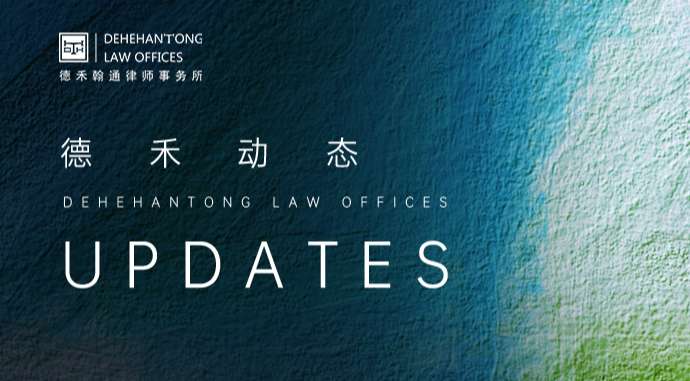Interpretation of Core Terms of the Investment Agreement (Part Four) - Priority Dividend Rights and Priority Investment Rights
I. Introduction
In the previous articles, we have systematically interpreted several common investor priorities, including the right of first refusal, the right of joint sale, the right of first refusal, the right of first refusal, the right of anti-dilution, the right of liquidation priority, and the right of first refusal. This article will further focus on the right of first dividend and the right of first refusal, which, although not universally applicable, are of great significance in specific transactions. And deeply analyze the underlying logic and key points of the negotiation.
Ii. Priority Dividend Rights
1. Basic concepts
Priority dividend right refers to the right of specific shareholders (usually referring to investor shareholders) to receive a certain proportion of dividends before other shareholders when the target company distributes dividends.
2. Legal basis
Since the core demand of investors is not to obtain stable dividends on a regular basis, the priority right to dividends is not a typical priority right in the transaction documents of PE/VC projects. However, it has a corresponding legal basis in the current Company Law. Article 210, Paragraph 4 of the Company Law of the People's Republic of China stipulates that the after-tax profit remaining after the company has made up for losses and set aside the reserve fund A limited liability company shall distribute profits to shareholders in proportion to their paid-in capital contributions, except where all shareholders agree not to distribute profits in proportion to their capital contributions. A joint stock limited company shall distribute profits in proportion to the shares held by its shareholders, except as otherwise provided in its articles of association.
Based on the above regulations, if dividends are not distributed in proportion to the capital contribution, the unanimous consent of all shareholders is required. Therefore, in practice, in addition to requiring all shareholders to unanimously recognize and sign the articles of association or shareholder agreement, the founding shareholders can also be required to bear the compensation liability for the dividend portion of the investors that exceeds their shareholding ratio.
3. Design purpose
As mentioned earlier, obtaining dividends is not the core purpose for investors to participate in PE/VC projects. However, if the priority dividend right can be stipulated in the transaction documents, it can ensure that investors can obtain relatively stable dividend returns and reduce the risk of the project failing and the investment being completely unrecoverable. In addition, this move can also be used to restrict the dividends of the target company and urge the founding shareholders to use the surplus funds for the further development of the target company, so as to achieve an overall exit in the later stage.
4. Common Classifications
(1) Whether it is cumulative
Cumulative priority dividend right refers to the situation where, within a certain financial year, the target company is unable to distribute dividends due to unprofitability or other reasons, and the investor has the right to demand that the target company make up the shortfall in subsequent dividend distributions.
(2) Whether to participate in subsequent dividends
Participatory priority dividend right refers to the situation where, after an investor receives the priority dividend, they can still participate in the distribution of the remaining distributable profits together with other shareholders in accordance with their respective shareholding ratios. Conversely, it is a non-participatory priority dividend right.
(3) Whether the annualized interest rate is fixed
The priority dividend right with a fixed interest rate is relatively beneficial to investors, ensuring that they receive a stable and predictable return. In practice, there are also agreements between the target company and the investors to regularly and dynamically adjust the annualized interest rate of the priority dividend by referring to the LPR.
5. Focus on key points
(1) Form of expression
At the practical level, the most important point for investors is to reflect the priority dividend right in the articles of association of the target company. This not only meets the requirement of the Company Law that it must be agreed upon unanimously by all shareholders, but also facilitates subsequent rounds of investors to promptly grasp this situation and avoid disputes arising from the addition of new shareholders. In addition, given the personal compensation liability of the founding shareholders mentioned earlier, it is also recommended that it be clearly stipulated in the transaction documents.
(2) Dividend distribution sequence
If the target company has undergone multiple rounds of financing, when it comes to the priority of dividend distribution, generally, investors from subsequent rounds are entitled to a higher priority in dividend distribution.
(3) Annualized interest rate
When investors claim the right of priority in dividend distribution, in addition to demanding the priority order of dividend distribution, they also require that the amount of dividend be calculated based on a certain annualized interest rate of the investment funds. This proportion is usually between 5% and 10%.
6. Restrictions proposed from the perspective of founding shareholders
From the perspective of benefiting founding shareholders, it is first recommended to strive for not granting investors priority dividend rights or excluding the personal compensation liability of founding shareholders. Secondly, it is advisable to negotiate a lower interest rate or refer to the LPR for regular dynamic adjustment. Additionally, it is suggested to clearly define the non-cumulative and non-participatory priority dividend rights that investors enjoy.
7. Model Clause
All parties agree that before other shareholders receive dividends, the investor is entitled to a priority dividend of 6% (simple interest) per annum of the investment amount paid by the investor in this transaction (the "priority dividend amount"). Where the company has paid the full amount of the priority dividend as agreed above, the remaining dividends or bonuses (if any) shall be distributed among all shareholders, including investors, in proportion to their shareholdings. Before the investor fully receives the above-mentioned priority dividend amount, other shareholders of the company shall not receive dividends in cash, property, company equity or any other form.
Iii. Priority Investment Right
1. Basic concepts
The right of first refusal to invest, also known as the right of first refusal to follow up, refers to the right of an investor to invest in new projects initiated by the founding shareholders within a certain period of time after the liquidation event of the target company, taking precedence over other investors at that time.
2. Legal basis
The right of first refusal is not a legal right under Chinese law and is not universally applicable in PE/VC projects. It usually appears in early-stage angel investment projects and is clearly stipulated by both the investor and the financier in the investment agreement.
3. Design purpose
"Investing in early-stage projects is investing in people." The business models of early-stage angel investment projects have often not yet been verified by the market. Investors are more based on their trust in the individual founding shareholders and their appreciation of their entrepreneurial ideas. However, in fact, the probability of early-stage project failures is very high, and the reasons are various, many of which are beyond the control of the founding team. Therefore, The existence of the right of first refusal enables investors to retain the right to continue trusting the founding shareholders, to continue participating in the new projects of their second venture, and to strive for investment returns.
4. Core issues
Whether the possible investment losses from previous projects are included in the new project, that is, whether the investor needs to actually contribute again when exercising the priority investment right, is the core issue that the founding shareholders and the investor focus on when negotiating the priority investment right. From the perspective of the founding shareholders, the early-stage project itself has investment risks, and the investor should bear them by themselves. From the perspective of investors, they would think that it is equivalent to paying for the personal growth of the founder with their own investment losses. Investors have reason to believe that the founder has already accumulated certain experience and resources in failed entrepreneurial projects, and it is more likely that they will be recognized by the market when engaging in new projects in the future. Therefore, the unrecovered investment losses from the investor's previous projects should be included in the new projects.
5. Focus on key points
For ease of understanding, we will illustrate here the key points that founding shareholders and investors pay attention to regarding the right of first choice in practice: Suppose an investor contributes 2 million yuan to participate in the angel round of financing of A certain start-up company A, with a pre-investment valuation of 8 million yuan, and enjoys the right of first choice. One year later, affected by many unfavorable factors, Company A applied for self-liquidation, and the investors did not receive any investment returns during this period. Two years later, the founder decided to make a comeback and established Company B to develop new projects. This time, the business model of Company B was recognized by the market. Company B now plans to raise 1 million yuan in its angel round, with a pre-investment valuation of 4 million yuan.
(1) Investment amount
Both the venture capital and the investor can freely agree on the investment amount for the investor to exercise the right of first refusal, which commonly includes being limited to the investment amount of the previous project or the investor's previous shareholding ratio in the target company. Take the former as an example. At this point, the investor has the right to exclusively enjoy the entire proposed financing amount of 1 million yuan of Company B. If both parties further agree that the investment losses of the previous project can be included in the new project, then the investor does not need to pay the investment amount again and can participate in the angel round of financing of Company B and hold 20% of its equity.
(2) Conditions for exercising the right
Both the venture capitalist and the investor may agree on the prerequisite conditions for the investor to exercise the right of first refusal to invest, such as the previous investment project not achieving profitability, the agreed performance guarantee not being fully or partially completed, and the investment cost that the investor fails to recover after the liquidation event reaches a certain proportion, etc.
(3) Exercise period
If the angel round investment agreement of Company A stipulates that the investor has the right to exercise the priority investment right, the investor can only participate in the angel round financing of Company B within one year after the liquidation event occurs. Since Company B is a new project that the founder started two years later, at this time, the investor cannot participate in the angel round financing of Company B by exercising the priority investment right. In practice, there are also situations where investors demand a strong binding with the founder, such as setting the exercise period for a relatively long time, or even an indefinite and permanent binding.
(4) Number of exercises
As mentioned earlier, the venture capitalist and the investor can agree on the exercise period of the priority investment right, and also on the number of exercise times. If the angel round investment agreement of Company A stipulates that the investor can only exercise the priority investment right once, then it can only participate in the first external financing of Company B, and the subsequent rounds of financing of Company B, Investors will then be unable to participate by exercising their right of first refusal.
6. Restrictions proposed from the perspective of founding shareholders
From the perspective of founding shareholders, in addition to striving to prevent the investment losses of investors in previous projects from being included in new projects, they can also avoid long-term and deep binding with investors by restricting the investment amount, exercise conditions, exercise frequency and exercise period, and try to only grant investors a one-time priority investment right for a single project.
7. Model Clause
If the company undergoes a liquidation event and the investors have not fully recovered the corresponding priority liquidation amount, within two years from the date of the liquidation event, if the founder, either alone or as a co-founder, engages in a new project independent of the target company, the founder shall disclose to the investors in advance the relevant information of the new project, including the financing plan, The investor has the right to invest in the new project before others, and the founder should cooperate.
Iiii. Conclusion
Although priority dividend rights and priority investment rights are not common standard features of investment and financing projects, they have also been frequently seen in early-stage projects in recent years. It is recommended that both venture capitalists and investors, on the basis of fully understanding the underlying logic and potential impact, carefully design and reasonably apply them to the project in light of specific circumstances.
Recommended Information
-
UpdatesDehehantong lawyers volunteer to provide foreign-related legal services - safeguarding the 8th China International Import Expo2025-11-18
-
UpdatesDehehantong has been awarded the qualification of the Industry-University-Research Practice Base of the Xuhui District Chamber of Commerce of Shanghai Business School2025-11-18
-
HonorsSeven cases of Dehehantong have been rated by LegalOne Merits2025-11-11
-
UpdatesDehehantong and the renowned British Law firm Belgravia Law jointly discuss a new chapter of cross-border legal collaboration2025-11-10
-
ArticlesKey points for defending project managers of construction companies against job-related crimes2025-11-07















